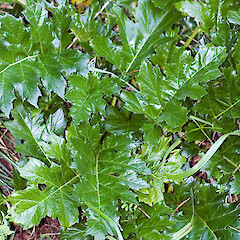Acanthus mollis
Common name
bear’s breeches
Family
Acanthaceae
Flora category
Vascular – Exotic
Structural class
Herbs - Dicotyledons other than Composites
Conservation status
Not applicable
Habitat
Usually found near old settlements, in partial shade and along riverbanks.
Detailed description
Perennial herb to about 120 cm, with thick roots. Petiole usually 10-50 cm on leaves arising from the root crown, much shorter (2-5 cm) on leaves arising from vertical stem. Leaves variable, but usually dark green and with several lobes. White flowers with pink, purple or brownish veins are produced on the central tall spike, these mature first at the bottom of the spike. Seeds are produced in individual capsules 3-4 cm long.
Similar taxa
Easily distinguished by the large divided leaves and the distinctive flower head.
Flowering
October, November, December, January, February, March, April
Flower colours
Red/Pink, White
Fruiting
November, December, January, February, March, April, May
Life cycle
Primarily escapes from cultivation by vegetative spread, although seed is viable. Dispersed by gravity, water and birds. Root fragments grow easily and once established this plant can be hard to eliminate from a site.
Year naturalised
1958
Origin
S.W. Europe
Reason for introduction
Ornamental
Tolerances
Can tolerate moderate shade, but flowers best in at least partial light.
Etymology
acanthus: From the Greek ákantha ‘thorn’
mollis: Soft






